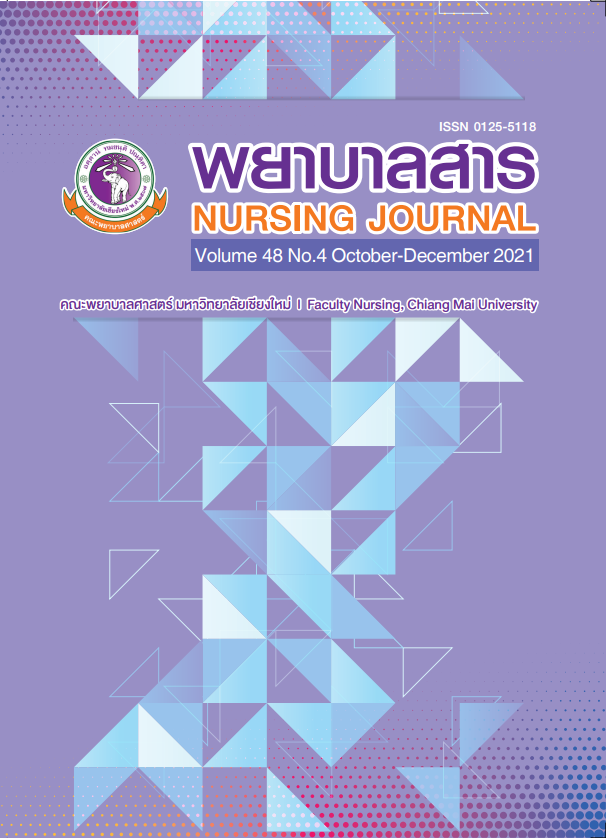ระดับความเครียดและปัจจัยที่สัมพันธ์กับความเครียดของพนักงานขับรถพยาบาลฉุกเฉิน
คำสำคัญ:
ปัจจัย, ความเครียด, พนักงานขับรถพยาบาลฉุกเฉินบทคัดย่อ
ความเครียดจากการทำงานเป็นอีกหนึ่งปัญหาสุขภาพที่สำคัญ โดยเฉพาะวิชาชีพที่ต้องทำงานเพื่อช่วยเหลือมนุษย์และให้บริการด้านการแพทย์ฉุกเฉิน การศึกษานี้เป็นการวิจัยแบบภาคตัดขวาง เพื่อประเมินระดับความเครียดของพนักงานขับรถพยาบาลฉุกเฉิน และเพื่อหาความสัมพันธ์ระหว่างปัจจัยส่วนบุคคลและปัจจัยการทำงานกับความเครียดของพนักงานขับรถพยาบาลฉุกเฉิน กลุ่มตัวอย่างที่ศึกษาคือพนักงานขับรถพยาบาลฉุกเฉินขององค์กรอาสาสมัคร 2 แห่ง ซึ่งผ่านการอบรมหลักสูตรพนักงานขับรถพยาบาลฉุกเฉิน จำนวน 83 คน รวบรวมข้อมูลระหว่างเดือนกรกฎาคมถึงเดือนกันยายน พ.ศ. 2563 เครื่องมือที่ใช้ในการวิจัยประกอบด้วย 3 ส่วนคือ ส่วนที่ 1 ข้อมูลส่วนบุคคล ส่วนที่ 2 ข้อมูลปัจจัยการทำงาน ซึ่งผ่านการตรวจสอบความตรงเชิงเนื้อหาจากผู้ทรงคุณวุฒิ 3 ท่าน ได้ค่าดัชนีความตรงเชิงเนื้อหาเท่ากับ 0.98 และทดสอบความเชื่อมั่นได้ค่าเท่ากับ 0.73 และ 0.76 ตามลำดับ ส่วนที่ 3 แบบวัดความเครียดสำหรับคนไทย (Thai Stress Test) มีความเชื่อมั่นของเครื่องมือแบบแอลฟาของครอนบาค (Cronbach’s alpha coefficient) เท่ากับ 0.84 วิเคราะห์ข้อมูลโดยใช้สถิติเชิงพรรณนาคำนวณหาความถี่และร้อยละ และวิเคราะห์หาความสัมพันธ์ระหว่างปัจจัยที่เกี่ยวข้องกับระดับความเครียดด้วยสถิติไคสแควร์ และสถิติฟิชเชอร์ ผลการศึกษาพบว่า 1. ระดับความเครียดจากการทำงานของพนักงานขับรถพยาบาลฉุกเฉิน ส่วนใหญ่อยู่ในระดับเครียดเล็กน้อย คิดเป็นร้อยละ 43.4 และอยู่ในระดับเครียดมาก คิดเป็นร้อยละ 12 2. ความเครียดมีความสัมพันธ์อย่างมีนัยสำคัญทางสถิติกับสถานภาพ รายได้เฉลี่ยที่ได้รับต่อเดือน รายได้เฉลี่ยของครอบครัวต่อเดือน ความเพียงพอของรายได้ต่อเดือน (P-value < 0.001) เวลาการเข้ากะทำงานต่อวัน (P-value < 0.05) ระดับผู้ป่วยฉุกเฉินวิกฤตที่พบขณะออกปฏิบัติการเฉลี่ยต่อวัน การประสบอุบัติเหตุขณะขับรถพยาบาลฉุกเฉินในระยะเวลา 1 ปีที่ผ่านมา (P-value < 0.001) การปวดกระดูกและกล้ามเนื้อบริเวณ ต้นคอ หลัง เอว (P-value < 0.05) และการรู้สึกได้รับความกดดันจากผู้ป่วยและหรือญาติของผู้ป่วยขณะปฏิบัติหน้าที่ (P-value < 0.001) ผลการศึกษานี้สามารถนำไปใช้เป็นข้อมูลพื้นฐาน เพื่อให้พนักงานขับรถพยาบาลฉุกเฉินและผู้ที่เกี่ยวข้องได้ทราบถึงปัจจัยที่มีความสัมพันธ์กับความเครียด นำไปสู่การให้ความรู้ คำแนะนำต่าง ๆ ที่เหมาะสมในการปรับตัวและการเผชิญกับปัจจัยที่มีความสัมพันธ์กับความเครียด
เอกสารอ้างอิง
AlEnzy, S. K., & AlEnzie, A. N. (2018). Stress and burnout among red crescent paramedic ambulance workers in Riyadh. [Electronic version]. Integrative International Journal of Current Research, 10(12), 75971-75976.
Caplan, G. (1964). Principles of preventive psychiatry. New York: Basic Books.
Chadbunchachai, W. (2008). Principles of development of emergency medical services system. Khon Kaen National Institute of Emergency Medicine. Standards and Criteria for Emergency Medical Systems (1). Nonthaburi: Ultimate Printing. (in Thai)
Cooper, C. L., & Marshall, J. (1976). Occupational sources of stress: A review of the literature relating to coronary heart disease and mental ill health. Journal of Occupational Psychology, 49(1), 11–28.
Halpern, J., Gurevich, M., Schwartz, B., & Brazeau, P. (2009). What makes an incident critical for ambulance workers? Emotional outcomes and implications for intervention. Work & Stress, 23(2), 173–189.
Hansen, C. D., Rasmussen, K., Kyed, M., Nielsen, K. J., & Andersen, J. H. (2012). Physical and psychosocial work environment factors and their association with health outcomes in Danish ambulance personnel - a cross-sectional study. BMC public health, 12(1), 534-540. Retrieved from https://pubmed.ncbi.nlm.nih.gov/22824415/
Krejcie, R. V. & Morgan, D. W. (1970) Determining sample sizes for research activities. [Electronic version]. Educational and Psychological Measurement, 30(3), 607-610.
Maguire, B. J., O'Meara, P. F., Brightwell, R. F., O'Neill, B. J., & Fitzgerald, G. J. (2014). Occupational injury risk among Australian paramedics: An analysis of national data. The Medical journal of Australia, 200(8), 477–480.
National Association of Emergency Medical Technicians. (2016). NAEMT 2016 EMS Mental Health Services Survey, In The Jems conference & exposition: Utah: Rampton Salt Palace Convention Center, Salt Lake City.
Nirel, N., Goldwag, R., Feigenberg, Z., Abadi, D., & Halpern, P. (2008). Stress, work overload, burnout, and satisfaction among paramedics in Israel. Prehospital and disaster medicine, 23(6), 537–546.
Okada, N., Ishii, N., Nakata, M., & Nakayama, S. (2012). Occupational stress among Japanese Emergency Medical Technicians: Hyogo Prefecture. Prehospital and Disaster Medicine, 20(2), 115-121.
Patcharatanasan, P., Ekburanawat, W., Kanoungkid, R., & Punyaratabandhu, M. (2016). Health hazards and traffic accidents during the operations of emergency vehicle drivers. Disease Control Journal, 42(4), 304-314.
Phattharayuttawat, S., Ngamtkipwatana, T., & Sukhatungkha, K. (2000). The development of the Thai stress test. Journal of Psychiatric Association of Thailand, 45(3), 237-250.
Pumfang, S., & Srisatidnarakul, B. (2015) Factors of job stress for Professional Nurses in Tertiary Hospital. [Electronic version]. Kuakarun Journal of Nursing, 22(2), 140-153. (in Thai)
Somboon, P. (2009). Stress and associated factors among Ruamkatanyu rescue workers in Bangkok Metropolis. (Master’s thesis). Bangkok: Chulalongkorn University. (in Thai)
Wachiradilok, P., & Sirisamutr,T. (2015). Mental health of ambulance drivers in the emergency medical service system. (in Thai) Retrieved from https://www.niems.go.th/1/Ebook/Detail/1009?group=28
ดาวน์โหลด
เผยแพร่แล้ว
รูปแบบการอ้างอิง
ฉบับ
ประเภทบทความ
สัญญาอนุญาต
บทความที่ได้รับการตีพิมพ์เป็นลิขสิทธิ์ของวารสารพยาบาลสาร
ข้อความที่ปรากฏในบทความแต่ละเรื่องในวารสารวิชาการเล่มนี้เป็นความคิดเห็นส่วนตัวของผู้เขียนแต่ละท่านไม่เกี่ยวข้องกับมหาวิทยาลัยเชียงใหม่ และคณาจารย์ท่านอื่นๆในมหาวิทยาลัยฯ แต่อย่างใด ความรับผิดชอบองค์ประกอบทั้งหมดของบทความแต่ละเรื่องเป็นของผู้เขียนแต่ละท่าน หากมีความผิดพลาดใด ๆ ผู้เขียนแต่ละท่านจะรับผิดชอบบทความของตนเองแต่ผู้เดียว






